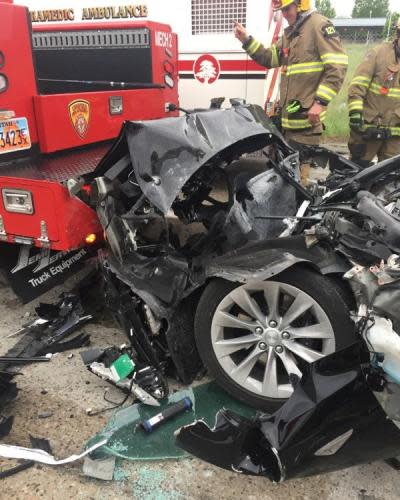Tesla confirms autopilot involved in Utah crash but seeks to blame driver

A Tesla car was driving in “autopilot” mode when it crashed into a stopped firetruck in Utah, the company said in a report to police that repeatedly cast blame on the driver, not its semi-autonomous driving system.
The confirmation that the vehicle’s technology failed to prevent it from colliding with a stopped object in its path came the same day that the US National Highway Traffic Safety Administration (NHTSA) announced it was sending a team to investigate the 11 May crash in Utah.
Tesla officials told police on Wednesday that the driver, who suffered a broken ankle when her Tesla Model S crashed, had turned on the “autosteer” and “cruise control” features about 80 seconds before the crash and taken her hands off the wheel, Tesla officials told police on Wednesday.
In recent weeks, Elon Musk’s electric car company has faced fresh scrutiny over the safety of its autopilot feature, which is supposed to assist drivers in navigating the road but cannot drive the cars on its own. In response to numerous high-profile autopilot crashes, including a fatal collision in California, the CEO has insisted that his technology is safer than traditional cars. Yet some experts have warned that the semi-autonomous features give drivers a false sense of security, allowing them to become easily distracted.
The 28-year-old Utah driver was looking at her phone before the collision and was given a traffic citation for “failure to keep proper lookout”, police said Wednesday.
Tesla’s report to police said there were more than a dozen instances of the driver taking her hands off the wheel for more than one minute at a time and that she only re-engaged when she was provided visual alerts.
“Drivers are repeatedly advised Autopilot features do not make Tesla vehicle ‘autonomous’ and that the driver absolutely must remain vigilant with their eyes on the road, hands on the wheel and they must be prepared to take any and all action necessary to avoid hazards on the road,” the company wrote.

The car was traveling at 60 miles per hour when the crash happened, Tesla said, adding that the driver manually pressed the vehicle brake fractions of a second before the collision. The driver’s use of autopilot was “contrary to proper use”, Tesla said, because she “did not pay attention to the road at all times” and used the feature on a street with no center median and with intersections controlled by stoplights.
Asked why the autopilot technology did not prevent the collision, a spokesperson told the Guardian in an email: “Tesla told police that the crash occurred because the driver did not pay attention to the road at all times, and that Autopilot is not intended for use without a fully attentive driver.”
The spokesperson also pointed to Tesla’s manual, which warns its drivers that the cruise control feature cannot detect all objects and may not brake or slow down for stationary vehicles and that its “automatic emergency braking” is not a substitute for drivers maintaining a safe distance from the cars in front of them.
Tesla also declined to comment on the NHTSA investigation. In recent weeks, the company has publicly feuded with US investigators over continuing federal inquiries related to autopilot.
Musk also criticized journalists for writing about the crash in a series of tweets earlier this week.
The first fatal autopilot crash happened in 2016 when Tesla’s software failed to “see” the white side of a tractor-trailer in its path against the backdrop of a white sky.

 Yahoo Finance
Yahoo Finance 